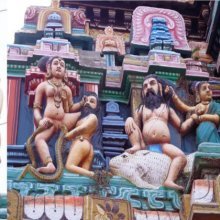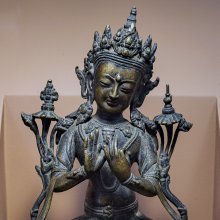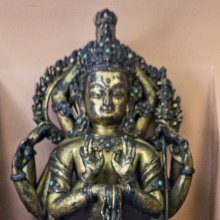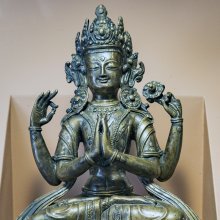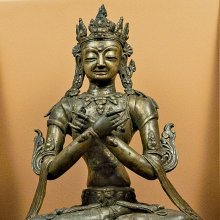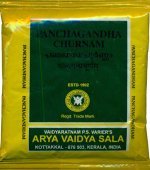Breast: 2 definitions
Introduction:
Breast means something in Hinduism, Sanskrit. If you want to know the exact meaning, history, etymology or English translation of this term then check out the descriptions on this page. Add your comment or reference to a book if you want to contribute to this summary article.
Images (photo gallery)
(+8 more images available)
In Hinduism
Natyashastra (theatrics and dramaturgy)
Source: Shodhganga: Elements of Art and Architecture in the Trtiyakhanda of the Visnudharmottarapurana (natya)The Breast (of a woman) is associated with Padmakośa-hasta: one of the twenty-two Single-hand Gestures (in Indian Dramas) (known as asaṃyuktahastas), according to the Viṣṇudharmottarapurāṇa, an ancient Sanskrit text which (being encyclopedic in nature) deals with a variety of cultural topics such as arts, architecture, music, grammar and astronomy.—The word padmakośa means the calyx of a lotus. [...] The uses of the padmakośa-hasta posture are not mentioned in the Viṣṇudharmottarapurāṇa. But according to the Abhinayadarpaṇa, this posture denotes some round shaped objects like breast of a woman, ball, round shaped cooking pot, egg and bell. The padmakośa posture is also used to show the blowing buds of flowers like marigold, lotus etc. Some kind of fruits like mango and wood apple are also portrayed with his hand posture.

Natyashastra (नाट्यशास्त्र, nāṭyaśāstra) refers to both the ancient Indian tradition (shastra) of performing arts, (natya—theatrics, drama, dance, music), as well as the name of a Sanskrit work dealing with these subjects. It also teaches the rules for composing Dramatic plays (nataka), construction and performance of Theater, and Poetic works (kavya).
Yoga (school of philosophy)
Source: ORA: Amanaska (king of all yogas): A Critical Edition and Annotated Translation by Jason BirchThe Breasts (of women) are denoted by the Sanskrit term Kuca, according to the Yogatārāvalī: a short Yoga text of twenty-nine verses presenting Haṭhayoga as the means to Rājayoga (i.e., Samādhi).—Accordingly, while describing the no-mind state: “Let this mind wander into thoughtless Samādhi or into a pair of voluptuous breasts (kuca-kalaśa-yuga) of [women] whose eyes are [as alluring as those of] the spotted black deer. Let it roam among the thoughts of idiots or the thoughts of the wise. The merits and faults produced by thought do not touch me, the king [of Rājayoga]”.

Yoga is originally considered a branch of Hindu philosophy (astika), but both ancient and modern Yoga combine the physical, mental and spiritual. Yoga teaches various physical techniques also known as āsanas (postures), used for various purposes (eg., meditation, contemplation, relaxation).
See also (Relevant definitions)
Ends with: Partridge-breast.
Full-text (+1241): Stana, Kuca, Stanya, Payodhara, Vakshoja, Stanantara, Cuci, Bhujantara, Uroja, Shrivatsa, Urasija, Kroda, Uras, Pivarastani, Vakshahsthala, Kaustubha, Stanabhoga, Urastas, Vakshas, Shrivatsakin.
Relevant text
Search found 237 books and stories containing Breast; (plurals include: Breasts). You can also click to the full overview containing English textual excerpts. Below are direct links for the most relevant articles:
Cosmetics, Costumes and Ornaments in Ancient India (by Remadevi. O.)
2.1. Upper Garments (n): Breast Cloth < [Chapter 2 - Costumes]
4. Dressing of Women < [Chapter 2 - Costumes]
1. Materials for Garments (d): Grass clothes < [Chapter 2 - Costumes]
Brihad Bhagavatamrita (commentary) (by Śrī Śrīmad Bhaktivedānta Nārāyana Gosvāmī Mahārāja)
Verse 1.7.46 < [Chapter 7 - Pūrṇa (pinnacle of excellent devotees)]
Verse 1.5.29 < [Chapter 5 - Priya (the beloved devotees)]
Verse 2.4.105 < [Chapter 4 - Vaikuṇṭha (the spiritual world)]
The Garuda Purana (by Manmatha Nath Dutt)
Chapter CLXXV - The Nidanam, of diseases peculiar to parturient women < [Dhanvantari Samhita]
Chapter LXIV - A brief discourse on the auspicious or in auspicious marks on the person of females < [Agastya Samhita]
Chapter CCXIII - Other Medicinal Recipes (continued) < [Dhanvantari Samhita]
Kathasaritsagara (the Ocean of Story) (by Somadeva)
Note on nail-marks and tooth-bites < [Notes]
Note on the practice of self-mutilation < [Notes]
Chapter LXXXIV < [Book XII - Śaśāṅkavatī]
The Brihaddharma Purana (abridged) (by Syama Charan Banerji)
Chapter 10 - History of the Bel tree (continued, 2)
Chapter 18 - History of Rama (continued, 3)
Garga Samhita (English) (by Danavir Goswami)
Verse 1.13.7 < [Chapter 13 - The Liberation of Pūtanā]
Verse 1.13.5 < [Chapter 13 - The Liberation of Pūtanā]
Verse 2.12.27 < [Chapter 12 - Subduing Kāliya and Drinking the Forest Fire]
Related products
(+10 more products available)
